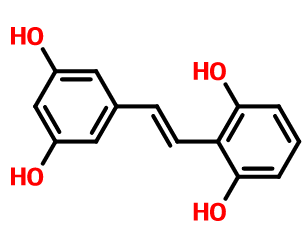Background and overview[1-2]
2,6,3′,5′-tetrahydroxystilbene is also called stilbene alcohol. Methyl alcohol is a stilbene monomer compound isolated from the genus Methyl. Pharmacological experiments show that it has strong anti-inflammatory and antioxidant activities.

Extraction method[1]
Extract 10 kg of the cane stems of A. microphylla with 80% ethanol three times, recover the solvent under reduced pressure to obtain an ethanol extract, disperse it with hot water, and extract it with petroleum ether, ethyl acetate, and n-butanol in sequence. Using a variety of column chromatography and thin layer preparative chromatography methods, compounds I (20 mg), II (30 mg), III (8 mg); IV (15 mg), V (20 mg) were separated from the ethyl acetate fraction. mg), VI (20 mg), VII (400 mg), VIII (100 mg), IX (33 mg), and compound X (150 mg) was separated from n-butanol. Ⅸ is 2,6,3′,5′-tetrahydroxystilbene.
Apply[2]
2,6,3′,5′-Tetrahydroxystilbene can be used to prepare 4-(6,8-dimethoxy-2-naphthyl)-1,3-benzenediol. 2,6,3′,5′-Tetrahydroxystilbene is a new type of phenylnaphthalene derivative produced by losing two benzene rings from the dimer of 2,6,3′,5′-tetrahydroxystilbene. Pharmacology Activity test results showed that 4-(6,8-dimethoxy-2-naphthyl)-1,3-benzenediol showed strong antioxidant activity. The preparation method is as follows:
2,6,3′,5′-tetrahydroxystilbene (259 mg) was dissolved in 40 mL 5% H2SO4 methanol solution, Heat to reflux with stirring for 48 h. Stop the reaction, add 150 mL of water to the reaction mixture, extract with EtOAc (50 mL×3), combine the organic layers, dry with Na2SO4, and concentrate under reduced pressure. Silica gel column chromatography of the paste, CHCl3-MeOH (V:V=500:1) was eluted to obtain 4-(6,8-dimethoxy-2-naphthyl)-1 , 3-phenylenediol (60 mg, 38.2%), light black amorphous powder, m.p. 162~164 ℃; UV-Vis (MeOH) λmax: 224, 257,304 nm; IR (KBr)νmax: 3370, 2935, 2827 , 1699, 1628, 1601, 1500, 1454,1402, 1342, 1286, 1207, 1159, 1111, 1045, 997, 926, 833,696, 671 cm ): 296 (M+, 100), 185(10), 132 (17), 93 (24), 69 (14). HR-FAB-MS calcd for C18H16O4 296.1049, found 296.1088.
References
[1]Wang Jianwei, Liang Jingyu, Li Li. Chemical composition of M. lobata[J]. Chinese Natural Medicines, 2006(06):432-434.
[2] Yao Chunsuo, Lin Mao, Yang Qingyun. Preparation of active dimer derivatives of manganol by oxidative coupling reaction and acid catalyzed reaction [J]. Organic Chemistry, 2013, 33(02): 312- 318.


